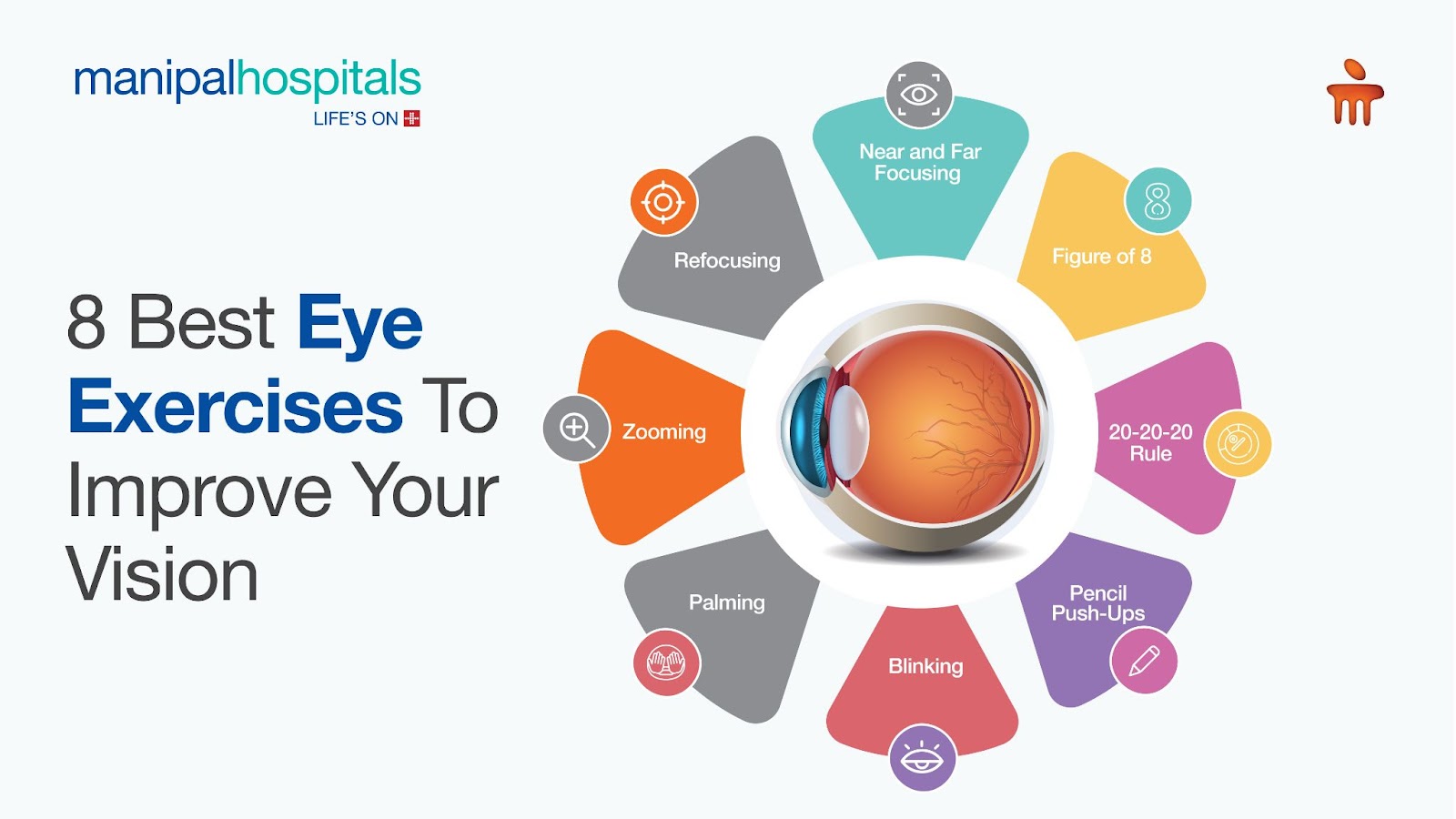
Good vision is essential, yet many of us neglect our eye health until problems arise. Fortunately, there are simple exercises that can help improve and maintain vision. In this blog, we'll explore 8 easy eye exercises that can be incorporated into your daily routine to promote better vision. Whether you're struggling with nearsightedness, farsightedness, or just want to keep your eyes healthy, these exercises can make a significant difference.
Synopsis
8 Eye Exercises to Improve Vision

1. Palming Technique
One of the simplest and most effective eye strengthening exercises is the palming technique. To perform this exercise, sit comfortably with your elbows on a table. Close your eyes and cover them with the palms of your hands, ensuring no light enters. Relax and breathe deeply for 1-2 minutes while visualising a peaceful scene. Palming helps relax the eye muscles, reduce strain, and improve circulation to the eyes.
2. Eye Rolling
Eye rolling is a straightforward exercise that helps improve eye flexibility and strength. Sit or stand comfortably and slowly look up towards the ceiling. Then, without moving your head, slowly roll your eyes in a clockwise direction for a few seconds, and then counter-clockwise. Repeat this motion several times, ensuring to blink between each rotation. Eye rolling helps prevent eye stiffness and enhances eye muscle control.
3. Focus Shifting
Focus shifting is beneficial for people who spend a lot of time looking at screens or performing close-up work. Hold a pen or pencil at arm's length, focusing on its tip. Slowly bring the pen closer to your nose while maintaining focus. Then, slowly move it back to arm's length. Repeat this process 10-15 times. Focus shifting exercises the muscles responsible for accommodation, which is the ability of the eyes to adjust focus between near and distant objects.
4. Near and Far Focusing
This exercise helps improve the flexibility of the eye muscles and enhances depth perception. Find a distant object to focus on, such as a tree or building, and another nearby object, like your finger or a pen. Alternate your focus between the distant object and the near object, shifting your gaze back and forth several times. This eye exercises to improve vision can be particularly beneficial for those experiencing age-related vision changes.
5. Blinking Exercise
Blinking is essential for keeping the eyes moist and preventing dryness, especially for individuals who spend prolonged periods staring at screens. Set a timer for every 20 minutes and blink rapidly for 10-15 seconds. This exercise helps lubricate the eyes, reduce eye strain, and refresh vision. Additionally, blinking helps distribute tear film evenly, promoting clearer vision.
6. Figure Eight Eye Exercise
The figure eight eye exercise is an excellent way to improve eye coordination and flexibility. Visualise an imaginary figure eight or infinity symbol horizontally in front of you. Slowly trace the figure eight with your eyes, focusing on smooth and controlled movements. Repeat this exercise for several repetitions, alternating between clockwise and counterclockwise directions. The figure eight eye exercise helps strengthen eye muscles and improve eye tracking ability.
7. The 20-20-20 Rule
While not a traditional eye exercise, following the 20-20-20 rule can significantly benefit eye health, especially for those who spend long hours in front of digital screens. Every 20 minutes, take a 20-second break and look at something 20 feet away. This practice helps reduce eye strain and fatigue by giving the eyes a chance to rest and refocus.
8. Zooming
Zooming eye exercises are a series of movements designed to improve visual focus and flexibility. These exercises are particularly beneficial for individuals who spend long hours in front of screens or those experiencing eye strain or fatigue. The goal of zooming exercises, or increase eyesight exercises, is to strengthen the eye muscles, enhance coordination between the eyes, and improve the ability to switch focus quickly between near and far objects.
If you experience ongoing eye strain or discomfort, it's a good idea to connect with a doctor online instantly. They can provide advice on the best exercises or treatments to improve your eye health and comfort
Incorporating these 8 simple eye exercises into your daily routine can go a long way in improving and maintaining your vision health. Remember to practice them consistently and consult with an eye care professional if you experience any persistent vision problems. By taking proactive steps to care for your eyes, you can enjoy clear and healthy vision for years to come.
FAQ's
It's recommended to perform these eye exercises daily for optimal results. Incorporating them into your daily routine, such as during breaks from screen time or before bed, can help improve eye health and prevent vision problems.
While these exercises may not eliminate the need for corrective eyewear, they can help improve overall eye health and potentially reduce the progression of certain vision problems. Consistency is key, and you may find that your prescription needs adjustment over time as your eye muscles become stronger and more flexible.
These exercises are suitable for individuals of all ages, from children to seniors. However, it's essential to perform them with caution and consult with an eye care professional if you have any underlying eye conditions or concerns.
While these exercises may not directly cure conditions like astigmatism or lazy eye, they can help improve overall eye function and may complement other treatments prescribed by your eye doctor. It's essential to discuss your specific condition and treatment plan with a qualified optometrist or ophthalmologist.
The timeframe for seeing results can vary depending on individual factors such as age, current eye health, and consistency of practice. Some people may notice improvements in a matter of weeks, while others may take longer. Patience and consistency are key, so continue practicing these exercises regularly for the best outcomes. If you experience any unusual symptoms or discomfort, consult with an eye care professional.





















 4 Min Read
4 Min Read










